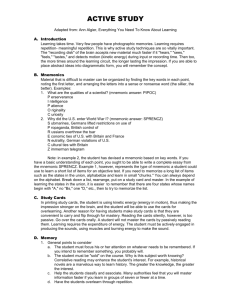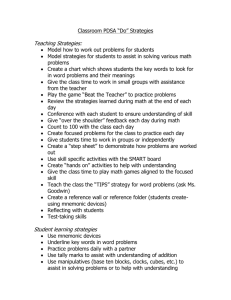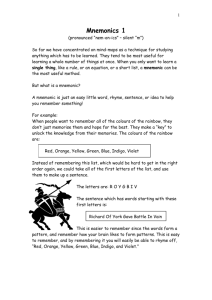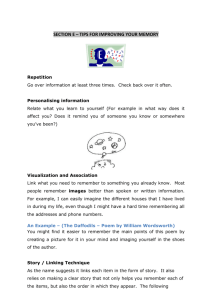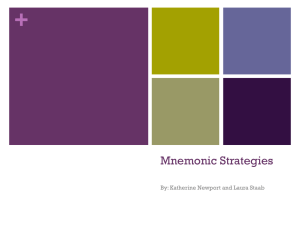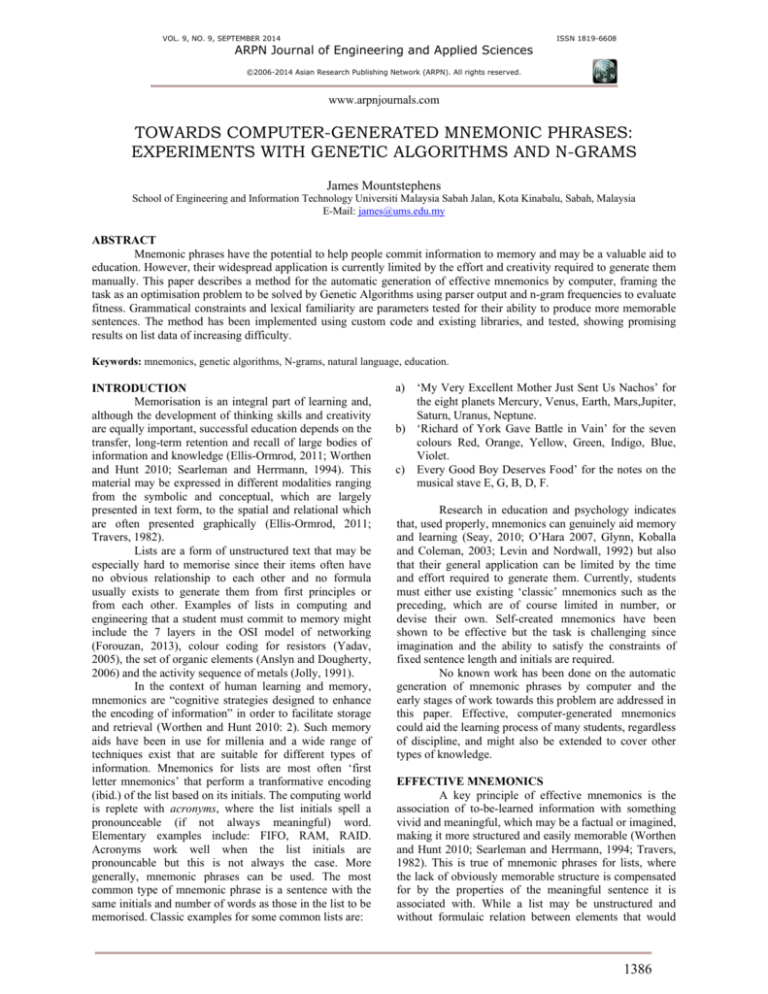
VOL. 9, NO. 9, SEPTEMBER 2014
ISSN 1819-6608
ARPN Journal of Engineering and Applied Sciences
©2006-2014 Asian Research Publishing Network (ARPN). All rights reserved.
www.arpnjournals.com
TOWARDS COMPUTER-GENERATED MNEMONIC PHRASES:
EXPERIMENTS WITH GENETIC ALGORITHMS AND N-GRAMS
James Mountstephens
School of Engineering and Information Technology Universiti Malaysia Sabah Jalan, Kota Kinabalu, Sabah, Malaysia
E-Mail: james@ums.edu.my
ABSTRACT
Mnemonic phrases have the potential to help people commit information to memory and may be a valuable aid to
education. However, their widespread application is currently limited by the effort and creativity required to generate them
manually. This paper describes a method for the automatic generation of effective mnemonics by computer, framing the
task as an optimisation problem to be solved by Genetic Algorithms using parser output and n-gram frequencies to evaluate
fitness. Grammatical constraints and lexical familiarity are parameters tested for their ability to produce more memorable
sentences. The method has been implemented using custom code and existing libraries, and tested, showing promising
results on list data of increasing difficulty.
Keywords: mnemonics, genetic algorithms, N-grams, natural language, education.
INTRODUCTION
Memorisation is an integral part of learning and,
although the development of thinking skills and creativity
are equally important, successful education depends on the
transfer, long-term retention and recall of large bodies of
information and knowledge (Ellis-Ormrod, 2011; Worthen
and Hunt 2010; Searleman and Herrmann, 1994). This
material may be expressed in different modalities ranging
from the symbolic and conceptual, which are largely
presented in text form, to the spatial and relational which
are often presented graphically (Ellis-Ormrod, 2011;
Travers, 1982).
Lists are a form of unstructured text that may be
especially hard to memorise since their items often have
no obvious relationship to each other and no formula
usually exists to generate them from first principles or
from each other. Examples of lists in computing and
engineering that a student must commit to memory might
include the 7 layers in the OSI model of networking
(Forouzan, 2013), colour coding for resistors (Yadav,
2005), the set of organic elements (Anslyn and Dougherty,
2006) and the activity sequence of metals (Jolly, 1991).
In the context of human learning and memory,
mnemonics are “cognitive strategies designed to enhance
the encoding of information” in order to facilitate storage
and retrieval (Worthen and Hunt 2010: 2). Such memory
aids have been in use for millenia and a wide range of
techniques exist that are suitable for different types of
information. Mnemonics for lists are most often ‘first
letter mnemonics’ that perform a tranformative encoding
(ibid.) of the list based on its initials. The computing world
is replete with acronyms, where the list initials spell a
pronounceable (if not always meaningful) word.
Elementary examples include: FIFO, RAM, RAID.
Acronyms work well when the list initials are
pronouncable but this is not always the case. More
generally, mnemonic phrases can be used. The most
common type of mnemonic phrase is a sentence with the
same initials and number of words as those in the list to be
memorised. Classic examples for some common lists are:
a)
‘My Very Excellent Mother Just Sent Us Nachos’ for
the eight planets Mercury, Venus, Earth, Mars,Jupiter,
Saturn, Uranus, Neptune.
b) ‘Richard of York Gave Battle in Vain’ for the seven
colours Red, Orange, Yellow, Green, Indigo, Blue,
Violet.
c) Every Good Boy Deserves Food’ for the notes on the
musical stave E, G, B, D, F.
Research in education and psychology indicates
that, used properly, mnemonics can genuinely aid memory
and learning (Seay, 2010; O’Hara 2007, Glynn, Koballa
and Coleman, 2003; Levin and Nordwall, 1992) but also
that their general application can be limited by the time
and effort required to generate them. Currently, students
must either use existing ‘classic’ mnemonics such as the
preceding, which are of course limited in number, or
devise their own. Self-created mnemonics have been
shown to be effective but the task is challenging since
imagination and the ability to satisfy the constraints of
fixed sentence length and initials are required.
No known work has been done on the automatic
generation of mnemonic phrases by computer and the
early stages of work towards this problem are addressed in
this paper. Effective, computer-generated mnemonics
could aid the learning process of many students, regardless
of discipline, and might also be extended to cover other
types of knowledge.
EFFECTIVE MNEMONICS
A key principle of effective mnemonics is the
association of to-be-learned information with something
vivid and meaningful, which may be a factual or imagined,
making it more structured and easily memorable (Worthen
and Hunt 2010; Searleman and Herrmann, 1994; Travers,
1982). This is true of mnemonic phrases for lists, where
the lack of obviously memorable structure is compensated
for by the properties of the meaningful sentence it is
associated with. While a list may be unstructured and
without formulaic relation between elements that would
1386
VOL. 9, NO. 9, SEPTEMBER 2014
ISSN 1819-6608
ARPN Journal of Engineering and Applied Sciences
©2006-2014 Asian Research Publishing Network (ARPN). All rights reserved.
www.arpnjournals.com
allow deduction of the next item, a sentence is intimately
bound together with long-range grammatical and semantic
dependencies that constrain the possible options. The
overall meaning of the sentence acts as a summary to both
contain and bind its constituents, especially if it can
produce vivid mental imagery.
Consider these principles in relation to the classic
mnemonic phrases of the previous section. The fact that
they are genuine sentences and not unrelated items is
crucial. For our purposes, this sentencehood means that
the words form a gramatically-acceptable structure in
terms of phrases and atomic parts-of-speech (POS) such as
nouns, verbs and adjectives. But, more than just syntax,
meaning makes the phrases work. Each of the examples
asserts something meaningful and capable of triggering or
creating a vivid or familiar mental image. Richard of York
really did give battle in vain; mothers frequently do give
their children nachos; and, all other things being equal,
good boys do deserve food. This meaning may be
understood at both a general and specific level. In general
terms, the entities in these phrases are compatible; the
subjects perform believable verbs on believable objects. If
My Very Excellent Mother Just Sailed Under Niagara, we
would likely be surprised. The meaning may also go
further to assert a specific fact rather than a generality, as
in the case of Richard of York.
Whether well-known or general entities should be
used in mnemonic phrases is not clear. Psycholinguistic
research suggests that more general concepts are often
harder to retrieve and/or picture and conversely that
familiar entity may activate a schema of related concepts
more readily (Miller, 1991; Gilhooly and Logie, 1980).
Such related concepts may offer useful ammunition for
establishing coherence in a phrase. For the example
phrases, the situation is not clear cut. Certainly, Richard of
York is a famous person in western culture, and those who
know of him might be expected to think of battles and of
losing. ‘My very excellent mother’ is unspecified by name
but should be easily picturable to most people. But ‘every
good boy’ seems less easily picturable. To explore the
question, this distinction between well-known and general
entities will be a key parameter in the experiments
described later.
A related question is that of bizarreness. The
example phrases are arguably successful because they
make true, familiar statements but the history of
mnemonics suggests that bizarreneness can be used
effectively memorable (Worthen and Hunt 2010;
Searleman and Herrmann, 1994). ‘Richard of York Grabs
Bears in Venice’ is also capable of inspiring a vivid
picture but our initial experiments have shown that
bizarreness is hard to get right and can easily descend into
gibberish. For example, ‘Richard of York Gets Bravely
into Vines’ somehow does not cut it. Investigating the use
of bizarreness will be left for future work.
With these concerns for grammar and meaning in
mind, the problem may now be formalised.
GENERATING MNEMONIC PHRASES
For an input list L of n words with initials IL, the
output mnemonic phrase mL will also be a sequence of n
words with initials IL. The question is: which sequence of
n words will best satisfy the conditions of grammar and
meaning just discussed? In this paper, the task will be
framed as an optimisation problem to be solved by search,
with a search space defined as follows.
Let W be a lexicon (a master list of words) and L
ϵ Wn be a list of words wL to be remembered. L is of length
n and has initials IL. Let mL ϵ Wn be a possible mnemonic
phrase for L. mL is a sequence of words wmL also with
length n and initials IL but wmL ≠ wL. Let ML be the set of
all mL determined by W and L. ML is the search space for
this problem. It is important to realise that W determines
the expressivity of the possible sequences, and, since L is
of fixed length, the size of W determines the size of the
search space. It should also be clear that the vast majority
of sequences in ML will be neither grammatical,
meaningful sentences nor useful mnemonics; they might
be expected to have no more memorable structure or
content than the original list L. The challenge will be to
select the best available sequence mL ϵ ML and we
therefore need to define an objective function to reflect our
criteria of grammar and meaning. This function will be of
the form
f(mL) = gr(mL) + mn(mL).
Grammar
The function gr(mL) must evaluate the
grammaticality of candidate word sequences and, since the
purpose of natural language parsers is determine this
structure in terms of phrases and parts-of-speech (POS),
their use will be explored.
Parsing is one of the oldest topics in
computational linguistics and there are many types of
parsers which vary in appropriateness for the task at hand.
Older parsers based on precision grammars will simply
reject any sentences that do not fit their grammar (Wagner,
Foster and Genabith, 2007; Chomsky, 1957). Although
this decisiveness is attractive, its cost in expressiveness
may be too high. Strict parsers are not well suited to
dealing with the vast number of looser grammatical
structures that people use everyday and some linguists
believe that making sentencehood as black and white as
this is not useful since people are usually capable of
imposing some structure on even unusual sequences of
words. Modern parsers based on Probabalistic ContextFree Grammars (PCFGs) (Klein and Manning, 2003) or
Link Grammars (Sleator and Temperly, 1995) can handle
more possible grammatical structures and are designed to
be tolerant of some level of grammatical abberation. They
can thus handle far larger domains but at the price of
accepting some sentences that humans would consider
ungrammatical.
For the purposes of this paper, use of modern,
more tolerant parsers will be explored since the nature of
the task already imposes strict constraints of sentence
1387
VOL. 9, NO. 9, SEPTEMBER 2014
ISSN 1819-6608
ARPN Journal of Engineering and Applied Sciences
©2006-2014 Asian Research Publishing Network (ARPN). All rights reserved.
www.arpnjournals.com
length and initials and so, for certain lists, a slightly more
flexible grammatical structure may be needed to make any
kind of sentence at all. This flexibility may be controlled
with a novel means of imposing grammatical strictness
that will be described later. For the function gr(mL),
modern parsers usually have a confidence level or cost
function accompanying their parse tree and that will be
used for evaluating grammaticality.
Meaning
Building a function mn (mL) to evaluate a
sentence for the criteria of meaning described earlier is
highly challenging. To reward sentences where the content
is compatible requires general knowledge of associations
between objects, their properties and possible actions. To
direct sentence content towards the assertion of specific
facts like those concerning Richard of York potentially
requires autobiographical and historic knowledge of the
specific actors involved.
A knowledge base may be explicitly stated or
may be implied by statistical regularities in appropriate
data (Russel and Norvig, 2010). Explicit knowledge
requires contruction and the development of suitable
inference strategies, which are beyond the scope of this
initial work. Here, implicit knowledge is explored in the
form of n-gram frequencies derived from large bodies of
machine-readable text known as corpora (Biber, Conrad
and Reppen, 1998; Sinclair, 1991). N-grams are
contiguous sequences of n items in a text and may be used
to evaluate meaning implicitly. Example bigrams (when
n=2) might include ‘at home’ and ‘apple hermit’; and
trigrams (when n=3) might be ‘on the road’ and ‘octopus
trait rheumatism’. It should seem reasonable that the first
example of each n-gram would have a higher frequency
than the latter and this information can be used to evaluate
candidate sentences. Those with higher frequency should
produce higher values of mn(mL).
Although not explicitly, n-grams embody some
grammatical and semantic regularities, as well as
familiarity of usage. Words co-occurring are likely to be
semantically related and the longer the n-gram, the longer
the range of the dependency between objects in a sentence.
Although long range dependencies are desirable, the use of
the n-grams of the same length as the input list to be
evaluated would be problematic since the frequency of any
particular n-gram decreases rapidly as n increases (Biber,
Conrad & Reppen, 1998). Matching and counting pairs of
words will produce plentiful results but matching and
counting a specific long sequence will not. The strictness
of longer n-grams means they can provide no frequency
for the vast majority of candidate word sequences. This
strictness means that local coherence is also not rewarded.
For example, when n=5, neither of the sequences ‘cat hat
you green backwards’ or ‘people like hurriedly high
mountain’ are likely to be found in a corpus but the latter
sequence is more locally coherent than the first due to
pairs of frequently-co-occuring words. Even if this were
not an issue and strictness is acceptable, n-gram frequency
decrease as n increases placing practical limits on n-gram
sizes since the corpus size must increase dramatically to
achieve statistically significant frequencies. For current
corpora, n is usually no greater than 5. To evaluate
sentences longer than five words, a simple frequency
count is not possible.
For these reasons, the way of using n-grams here
to evaluate meaning is to check each possible n-gram
(n=2,3,4,5) on each possible word in the candidate
sequence from left to right, taking care to not exceed the
right end of the sequence. Using n-grams of all sizes will
rewards pockets of local coherence even when the whole
sequence does not match the contents of the corpus.
Figure-1. Summing all possible n-grams in
all possible positions.
Genetic Algorithms
Given the components of the objective function
just described, a search method must be chosen.
Exhaustive search is arguably the best but the search space
is likely to be large for a lexicon of reasonable size. For
this research, Genetic Algorithms (GA) will be used to
perform the search since they have proven to be robust and
capable of rapid convergence in a wide range of problems
(Russel and Norvig, 2010; Mitchell, 1996).
Taking inspiration from biological reproduction
and evolution, the basic unit in a GA is the chromosome,
which comprises a sequence of genes taking particular
values known as alleles. For the generation of a mnemonic
phrase for the organic elements (carbon, hydrogen,
nitrogen, oxygen, phosphorus, sulphur), example
chromosomes might be as below:
Figure-2. Four example chromosomes, each with with six
genes.
Although the specifics of GAs are beyond the
scope of this paper, the essential idea is that initial
populations of chromosomes are assessed for fitness (the
GA version of an objective function) and the fittest
1388
VOL. 9, NO. 9, SEPTEMBER 2014
ISSN 1819-6608
ARPN Journal of Engineering and Applied Sciences
©2006-2014 Asian Research Publishing Network (ARPN). All rights reserved.
www.arpnjournals.com
allowed reproducing to form new chromosomes. In the
example above, the left and right halves of C1 and C3
have high fitness and might combine to form the better
chromosome [cut his nose off peter smith] which is a
grammatical sentence and a reasonable mnemonic phrase
for the list of organic elements. The process of evolution is
continued until chromosomes with a desired level of
fitness are produced.
Extending the Search
A considerable number of options exist to extend
the basic search framework just described. Two key
parameters that will be tested are i) the effectiveness of the
more flexible parser chosen earlier in achieving correct
grammar and ii) whether well-known or general entities
give the best results. Both questions can be addressed by
placing appropriate constraints on the search and
determining which works best.
Constraining Grammar
The tradeoff between strict and flexible grammar
has been noted and it is understood that the choice here of
a flexible parser may not be appropriate; it may be
necessary to impose stricter grammatical constraints on
word sequences generated. One method, explored here, is
to determine a legal grammatical structure before the
search begins, effectively binding positions in all
candidate sequences to particular parts-of-speech. The
search will still continue using the parser and n-grams but
the output can be expected to be at least an acceptable
sentence. This constraint may also vastly reduce the search
space since, at a given position in the candidate sequence;
allowable words must not only have the correct initial but
must also have the correct POS.
Phrase Structure Grammars (Russel and Norvig
2013, Sag and Wasow 1999; Chomsky 1957) are explored
for this task. PSGs are essentially rewrite rules for partsof-speech, as illustrated below.
Figure-3. Simple Phrase Structure Grammar (PSG).
These rules may be used to recursively divide the
input list L into phrases and ultimately into atomic POSs
like nouns and verbs. If the assignment is possible, it is
guaranteed to be a grammatical sentence. The added
difficulty in this context is that the words in the sequence
are bound to fixed initials and the assigned POS must exist
for a given initial. An example of this process successfully
applied to L= {E, G, B, D, F} using the PSG from Figure3 is shown below.
Figure-4. Success in constraining grammar using the PSG
in Figure-3.
The division of the word sequence may vary. In
this example, the initial split could have been NP = {E, G,
B} and VP = {D, F} instead. Different divisions will yield
different sentence structures and in certain cases will
produce a sentence structure for which words with the
correct initial for the assigned POS do not exist. An
example of this situation might occur for L= {carbon,
hydrogen, nitrogen, oxygen, phosphorus, sulphur} using
the same PSG.
Figure-5. Failure in constraining grammar using the PSG
in Figure-3.
At the third stage, the initial ‘C’ has been
assigned the POS ‘article’ but there is no English article
beginning with ‘C’, rendering the sentence unrealisable.
Steps must be taken to check if a generated sentence
structure is compatible with the given initials and if not, to
redivide the sequence and recurse again, which will assign
a different POS to the initial in question, as shown below.
Figure-6. Correction of invalid assignment by redividing
sequence.
Constraining Lexicon
Earlier, the issue of the specificity of the entities
in the sentence was raised. It was asked whether sentences
about famous people and the entities associated with them
are intrinsically more vivid and memorable than sentences
about general nouns such as people and cars.
To explore this in experiment, famous names and
associated entities may be used simply by binding the
names to positions in the sequence before the search
begins. In essence, leaving gaps to be filled in with more
1389
VOL. 9, NO. 9, SEPTEMBER 2014
ISSN 1819-6608
ARPN Journal of Engineering and Applied Sciences
©2006-2014 Asian Research Publishing Network (ARPN). All rights reserved.
www.arpnjournals.com
general words. This may combined with the grammatical
constraints described in the previous section to also bind
the POS of the remaining placeholders.
To automate this process, the input list L is
scanned for locations to insert famous names and their
associated entities based on compatibility of initials. So for
CHNOPS, the famous person Cleopatra might be assigned
to the initial C, making her the subject of the sentence.
Cleopatra is associated with a number of other entities
such as hieroglyphics, needles, the Nile, Osiris, pyramids,
pharoahs, sarchophagi and the Sphinx, that could
potentially make a coherent sentence and have initials
compatible with other positions in the list. It should also
be clear, however, that there is only room for one or two
of these other entities in the short sequence of six words
and that space must be left for verbs, adjectives and
function words to make a genuine sentence.
IMPLEMENTATION
The method described so far is intentionally
general and a number of parameters must set concretely in
any implementation of it. The implementation choices
used in the experiments described later are described next.
In addition to the use of existing libraries, a considerable
body of custom Java code was developed for reading and
converting linguistic data, interfacing GA and parser
libraries and implementing the grammar and famous
names constraints described in section 3.
Lexical Data
Choice of lexicon W is crucial since it determines
the content, coherence and expressiveness of the phrases
that can be generated. It also determines the size of the
search space for the problem and should therefore not be
too large. A number of options were considered for both
general words and famous names.
At the extreme end of expressiveness for general
words, we might use the set of distinct words in a large
natural language corpus such as the British National
Corpus (BNC, 100 million words) (Burnage, 1991) or the
Corpus of Contemporary English (COCA, 450 million
words) (Davies, 2011) since they both have lexica of over
500,000 distinct words and it would also be convenient to
extract n-grams from the same data. But, even if efficiency
were not an issue for such a large lexicon, our initial
experiments suggested that the vast majority of sequences
generated were uncomfortably odd since words from many
different contexts were being combined. Certainly,
frequency could be used to determine the most frequent
and reject the rest but even if frequency was able to
determine a smaller set of more familiar words there is
still no guarantee that they form an expressive and
coherent set. Inspection of the BNC suggests not and it
will be left for future work to explore different methods of
using the lexica of corpora directly.
Alternatively, specialised languages are designed
to be coherent and expressive using a small number of
words. Ogden’s Basic English (BE, 850 words) (Ogden,
1937) was a major candidate and was used in early tests.
However, BE does not directly give POS categories to its
words and expressly tries to eliminate verbs in favour of a
small number of action words, resulting in sentences that
sound extremely unnatural. Another specialised language,
The Voice of America (VOA) 1500 word list (Voice of
America, 2013), can be considered a simplified, distilled
version of English intended for description since it was
devised to allow broadcast of the same content in 46
different language. Unlike BE, it has verbs and six simple
POS tags. This is the lexicon used here.
A number of sources of famous names were also
considered and judged based on expected quality and ease
of machine extraction. The Notable Names Database
(NNDB) (NNDB, 2013) features a large number of
famous people and the accompanying textual biographies
contain the potential for extracting terms associated with
these people. As an online-only database, it would require
considerable work to extract the basic data and, since the
biographies are unstructured text, to extract genuine
associated terms.
Instead, the results of an online poll attempting to
decide the most famous people (Famous, 2013) was used
as a basic list of 150 famous people and included such as
Marilyn Monroe and Winston Churchill. 20 associated
terms for each name were derived using Google Sets,
whose purpose is to do exactly that. It should be noted that
Google Sets has unfortunately been closed down and its
functionality is now only accessible manually through
Google Sheets, an issue we hope to automate soon.
N-Gram data
N-gram data was taken from the 450-million
word Corpus of Contemporary American English
(COCA). The top million n-grams for n=2, 3, 4, 5 are
available free in a convenient text file format (N-grams,
2013). The lexicon determined by the n-grams is far larger
than the VOA chosen for these experiments and was
therefore aligned and substantially trimmed by mapping
across lemmas and differing POS conventions. The
separate lists for each n were combined into a single tree
structure for more efficient querying. Although we would
have liked to use British English, COCA is 4.5 times
bigger than the BNC and its size allows better frequency
estimates for longer n-grams making it the best choice
here.
GA Library
The Java Genetic Algorithms Library JGAP
(JGAP, 2013) is a freely-available implementation of
many established genetic algorithms. It offers classes and
methods for generating and evolving populations and
calculating customised fitness functions.
Parser Library
Two main options for parser library were
considered in this implementation. Arguably the most
popular freely-available general english parser, the
Stanford Parser (Stanford, 2013) is considered state-ofthe-art and can generate a parse probability that can be
1390
VOL. 9, NO. 9, SEPTEMBER 2014
ISSN 1819-6608
ARPN Journal of Engineering and Applied Sciences
©2006-2014 Asian Research Publishing Network (ARPN). All rights reserved.
www.arpnjournals.com
used in the fitness function required here. Alternatively.
The CMU Link Parser (CMU, 2013) is freely-available as
a Java library and although poorly-documented, it can be
used to generate linkage and cost data for a given
sentence.
The choice was made in favour of the Link Parser
after initial experiments demonstrated that the Stanford
parser was considerably slower (about 2 secs vs 0.5 secs
per word sequence). Note that the Link Parser has a cost
function rather than a parse probability and higher values
will therefore reduce the fitness function rather than
increase it.
EXPERIMENTS
Since our method is still being refined, evaluation
of the mnemonics generated will be by inspection here.
With more refinement, the mnemonics will soon be tested
on real students and their effectiveness will be determined
more objectively. Four lists of increasing length were
used:
a)
Undergraduate computer scientists learn that
executable code is generated by ‘lexical analysis,
parsing, code generation’. This list has five words and
initials L A P C G.
b) The list of organic elements ‘carbon, hydrogen,
nitrogen, oxygen, phosphrous, sulphur’. This list has
six words and initials C H N O P S.
c) The seven layers in the OSI networking model,
‘physical, datalink, network, transport, session,
presentation, application’ have initials P D N T S P A.
d) Electrical engineers need to memorise the list of 12
resistor colour codes: ‘black, brown, red, orange,
yellow, green, blue, violet, grey, white, gold, silver’.
Initials are B B R O Y G B V G W G S. This is the
longest list and is expected to be challenging.
The experimental design is straightforward: after
a randomly-generated baseline sequence is found for each
list, the two parameters described earlier are varied: ie
general nouns vs famous names and POS constraints vs no
POS constraints. The results are described next.
Random Baseline
Unsurprisingly, random sequences of words
chosen from even this relatively small and controlled
lexicon do not yield meaningful grammatical sentences, as
shown below.
Table-1. Random Baseline.
List
LAPCG
CHNOPS
PDNTSPA
BBROYGBVG
WGS
Mnemonic Phrase
Love after parent combine guerrilla
Collect happen nice offensive plenty
seek
Peace design news technical social
poverty about
Bus bring red oppose yet
grandmother bottom very group
white guarantee several
Reading these sequences, we may notice
ourselves automatically trying to detect or impose form
and meaning on the sequences but should be
uncontroversial to say that none of them constitute useful
mnemonics. These sequences provide a baseline to
appreciate the effects (if any) of our method and the
paremeters under investigation.
No POS constraints
The basic capability of the GA and fitness
function combination on general words is demonstrated in
Table-2 below. The parser and n-grams appear to be
enforcing some degree of local syntactic and semantic
coherence, which is a noticable improvement over
baseline.
Table-2. General Nouns, No POS constraints.
List
Mnemonic Phrase
LAPCG
Look at peace common ground
CHNOPS
PDNTSPA
Contain high number of people say
People develop new to school
professor at
Baby boy risk of young girl born
violate go with great story
BBROYGBVG
WGS
However, if even structurally-poor sentences
were to be accepted, there is little memorable in their
content. The effect of using famous names instead of
general nouns is shown next. After scanning each input list
and querying the list of famous names described in 4.1,
certain positions in each list were automatically
constrained to a number of famous people and associated
objects, not exceeding a total of 1/3 of the list length. The
results are shown in Table-3.
Table-3. Famous Names, No POS constraints.
List
Mnemonic Phrase
LAPCG
Let Aristotle pay city government
Cleopatra high number of people
Sphinx
Plato develop notes to school Pamela
Anderson
Below Beyonce risk of young girls
below volcano George Washington
go see
CHNOPS
PDNTSPA
BBROYGBVG
WGS
The grammatical improvement over baseline is
also noticable here but content more vivid than that of
general words has also been generated for the first and
third lists. Unintentionally, the bizarreness of Plato helping
to educate Pamela Anderson does seem quite memorable.
However, the second and last lists are neither grammatical
nor clearly meaningful. The twelve-word list particularly
struggles for coherence and seems to demand being split
into smaller sentences.
1391
VOL. 9, NO. 9, SEPTEMBER 2014
ISSN 1819-6608
ARPN Journal of Engineering and Applied Sciences
©2006-2014 Asian Research Publishing Network (ARPN). All rights reserved.
www.arpnjournals.com
POS constraints
The previous results suggest that the parser and
n-grams can enforce some degree of grammatical structure
on a sequence but here we pre-constrain the POS sequence
for each list using the method described in 3.4.1. Although
the structure may be less interesting, it may provide a
means to improve meaning. This is shown below for
general words.
Table-4. General Nouns, POS constraints.
List
Mnemonic Phrase
LAPCG
Large amounts probably create gas
Calm husbands never open public
schools
Perfect days never tell strong public
art
Big bright red opinions yearly green
broadcast very good way game since
CHNOPS
PDNTSPA
BBROYGBVG
WGS
Grammatical constraints have a considerable
effect on normalising the sequences into recognisable
sentences. Even with general words, the two shorter
sequences produce genuine but ambiguous statements. The
generated phrase for the chemical elements is actually
quite acceptable. The twelve-word sequence is better
organised but remains nonsense. Using famous names in a
grammatically-sound structure produces the output shown
below.
Table-5. Famous Names, POS constraints.
List
LAPCG
CHNOPS
PDNTSPA
BBROYGBVG
WGS
Mnemonic Phrase
Liberal Aristotle probably creates
Gandhi
Cleopatra’s huge needle only
provides Sphinx
Plato’s dead, never tell sweet Pamela
Anderson
Beautiful Beyonce responsibly obeys
young girls below vicious George
Washington getting service
Again, bizarreness due to the anachronisms of the
entities involved is apparent but this is the best output so
far. The OSI mnemonic strikes a good balance between
oddness and coherence: that someone is dead is probably
upsetting so don’t tell, but would the Baywatch actress
really be concerned about philosopher Plato (no offence to
her intellectual sensibilities intended)?
CONCLUSIONS
This paper has described progress on the
development of a method for the automatic generation of
mnemonic phrases for list information. The experimental
results just presented are promising but more work is
required before human testing is conducted. There are a
large number of parameters in every component of the
system that can be varied, both conceptually and in terms
of implementation choices. It is too early to say that
constraining POS and using famous names is definitively
better, but that is the conclusion suggested by these early
experiments. It was mentioned earlier that bizarreness was
not to be studied in this paper but the experiments
produced it anyway. Managing the dissonance between
expectations in a controllable way without descending into
gibberish will be an interesting challenge. We are also
aware that famousness is culturally relative and this
suggests the intriguing possibility of more personalised
mnemonics. For example, to personalise a mnemonic
phrase for the organic elemens for asian learners, words
more likely to be memorable might be used: ‘Come Home,
Neighbour Of President Sukarno’. To personalise the same
list for a Briton to remember, an alternative formulation
might be more memorable: ‘Chelsea Has No Other
Players, Sorry!’
REFERENCES
Anslyn E.V. and Dougherty D.A. 2006. Modern Physical
Organic Chemistry. University Science Books.
Biber B., Conrad S. and Reppen R. 998. Corpus
linguistics: investigating language structure and use.
Cambridge: Cambridge University Press.
Burnage A.G. 1991. Text Corpora and the British
National Corpus. In Computers and Texts 2, 7-8.
Chomsky. N. 1957. Syntactic Structures. Mouton.
CMU. 2013. http://www.link.cs.cmu.edu/link/.
Davies M. 2011. The Corpus of Contemporary American
English as the First Reliable Monitor Corpus of English.
Literary and Linguistic Computing. 25: 447-65.
Ellis-Ormrod J. 2011. Educational
Developing Learners. Pearson.
Psychology,
Famous. 2013. http://www.whoismorefamous.com/.
Forouzan B.A. 2013. Data Communications
Networking. New York, McGraw-Hill.
and
Gilhooly K.J. and Logie R.H. 1980. Age of acquisition,
imagery, concreteness, familiarity and ambiguity measures
for 1944 words. Behaviour Research Methods and
Instrumentation. 12, pp. 395-427.
Glynn S., Koballa T. and Coleman D. 2003. Mnemonic
Methods, Science Teacher. 70(9): 52-55.
JGAP. 2013. http://jgap.sourceforge.net/.
Jolly W.L. 1991. Modern Inorganic Chemistry (2nd ed.).
New York, McGraw-Hill.
1392
VOL. 9, NO. 9, SEPTEMBER 2014
ISSN 1819-6608
ARPN Journal of Engineering and Applied Sciences
©2006-2014 Asian Research Publishing Network (ARPN). All rights reserved.
www.arpnjournals.com
Klein D. and Manning C.D. 2003. Accurate Unlexicalized
Parsing. In Proceedings of the 41st Meeting of the
Association for Computational Linguistics. pp. 423-430.
Levin J.R., Nordwall M.B. 1992. Mnemonic vocabulary
instruction:
Additional
effectiveness
evidence.
Contemporary Educational Psychology. 17(2): 156-174.
Miller G.A. 1991. The Science of Words. W H Freeman
and Co.
Wagner J., Foster J. and Genabith J.V. 2007. A
Comparative Evaluation of Deep and Shallow Approaches
to the Automatic Detection of Common Grammatical
Errors. In Proceedings of the 2007 Joint Conference on
Empirical Methods in Natural Language Processing and
Computational Natural Language Learning. pp. 112-121.
Yadav P. 2005. Electrical Engineering. New Delhi,
Discovery Publishing House.
Mitchell M. 1996. An Introduction to Genetic Algorithms.
Cambridge, MA: MIT Press.
N-grams. 2013. http://www.ngrams.info/.
NNDB. 2013. http://www.nndb.com.
Ogden C.K 1937. Basic English and Grammatical Reform,
Cambridge: The Orthological Institute.
O'Hara R. 2007. Long-term effects of mnemonic training
in community-dwelling older adults. Journal or Psychiatric
Research. 41(7): 585-90.
Russell S. and Norvig P. 2010. Artificial Intelligence: A
Modern Approach, 3rd Edition. Prentice-Hall.
Sag I. and Wasow T. 1999. Syntactic theory: A formal
introduction. Stanford, CA: CSLI Publications.
Searleman A. and Herrmann D. 1994. Memory From A
Broader Perspective, New York: McGraw-Hill.
Seay S.S. 2010. The Use/Application of Mnemonics As a
Pedagogical Tool in Auditing, Academy of Educational
Leadership Journal. 14(2).
Sinclair J. 1991. Corpus, concordance, collocation.
Oxford University Press.
Sleator D. and Temperly D. 1993. Parsing English with a
Link Grammar. Third International Workshop on Parsing
Technologies.
Stanford.
2013.
parser.shtml.
http://nlp.stanford.edu/software/lex-
Travers R.M.W. 1982. Essentials of Learning. New York,
Macmillan.
Voice
of
America
2013.
http://simple.wikipedia.org/wiki/Wikipedia:VOA_Special
_English_Word_Book.
Worthen J.B. and Hunt R.R. 2011. Mnemonology:
Mnemonics for the 21st Century. Essays in Cognitive
Psychology, Psychology Press.
1393



